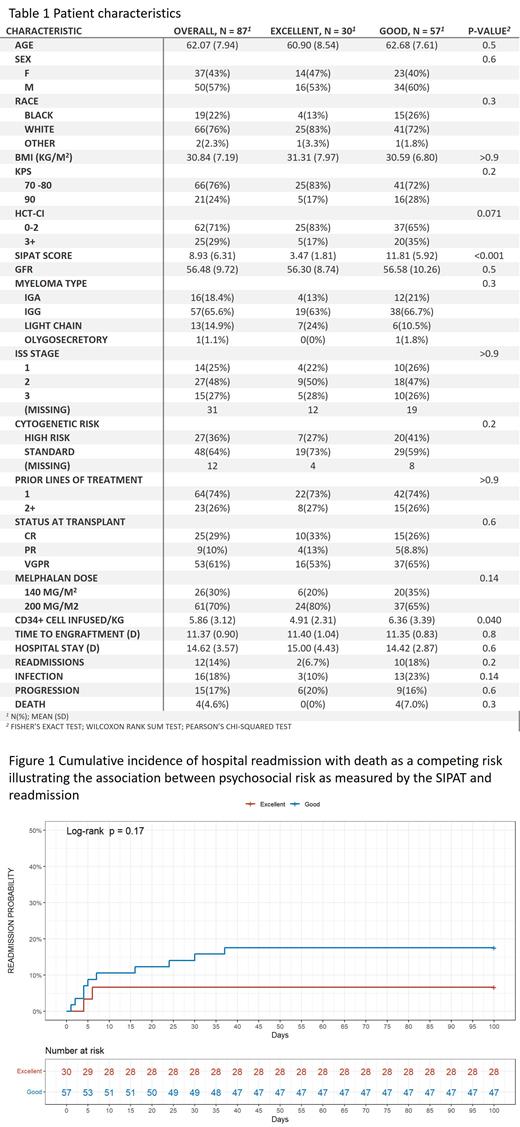Background: Hematopoietic stem cell transplant (SCT) is a high-intensity treatment that can cause psychological distress. Pre-transplant psychosocial screening is commonly used to assess mental health, social support, compliance, and health behaviors in HCT centers. However, the optimal standardized approach to psychosocial screening is still being defined. Some studies have shown that pre-transplant psychosocial assessments can predict overall survival (OS) after SCT, while others have found associations with non-relapse mortality (NRM) but not with OS. Single-institution reports consistently indicate that pre-HCT psychosocial assessments are associated with the length of SCT hospitalization and readmission rate.
The Stanford Integrated Psychosocial Assessment for Transplantation (SIPAT) is an established tool in the solid organ transplant field that can be used to assess and quantify psychosocial risk, that can help in patient selection and pre-transplant preparation.
Objective: This study aimed to validate the SIPAT as a standardized psychological assessment in patients with multiple myeloma (MM) undergoing autologous SCT (ASCT). The primary goal was to analyze the impact of psychosocial risk, as measured by the SIPAT score, on the length of hospital stay and readmission rates within 100 days post-discharge. Secondary outcomes included the risk of infections, progression-free survival (PFS), and overall survival (OS).
Methods: This retrospective, single-center study included 87 patients with MM who underwent ASCT between 2019 and 2022 at University Hospitals Seidman Cancer Center. Patient and disease characteristics were collected, and SIPAT scores were recorded for all patients. Patients were grouped based on their SIPAT scores as “Excellent” (score ≤ 6) or “Good” (score > 6). Hospitalization duration during transplant, readmissions, and infections within the first 100 days after ASCT were used as indicators of treatment-related toxicity.
Results: 30 patients had an “Excellent” SIPAT score (mean score: 3.47, SD 1.81), while 57 had a “Good” score (mean score: 11.81, SD 5.92). Both groups exhibited similar sex and race distribution, BMI, and KPS scores. The “Excellent” SIPAT group had more patients with HCT-CI scores of 0-2. Both groups had comparable ISS staging and high-risk cytogenetics, along with similar prior lines of treatment and disease status at the time of transplant. Patients in the “Good” SIPAT score group had a higher number of CD34+ cells infused per kg. No significant differences were observed between the groups in terms of engraftment time, hospitalization duration, or rates of hospitalizations and infections within the first 100 days after transplant. Univariate analysis of risk of readmissions showed that BMI had a significant effect (HR 1.09, 95% CI 1.02-1.16, p=0.009) for each unit increase and HCT-CI had a significant effect (HR 5.56, 95% CI 1.39-22.24, p=0.015) for HCT-CI score 3+ compared to 0-2. However, in the multivariable model, these effects did not persist.
Conclusions: Although the SIPAT tool is widely used for evaluating different organ transplants, including HCT, a high SIPAT score alone may not be sufficient to risk-stratify candidates for ASCT in MM. Further research and evaluation are warranted to better understand the true predictive value of pre-transplant psychosocial assessments.
Disclosures
Malek:Sanofi: Consultancy; Medpacto Inc.: Research Funding; Cumberland Inc.: Research Funding; BMS: Consultancy; Karyopharm: Speakers Bureau; Amgen: Speakers Bureau.


This feature is available to Subscribers Only
Sign In or Create an Account Close Modal